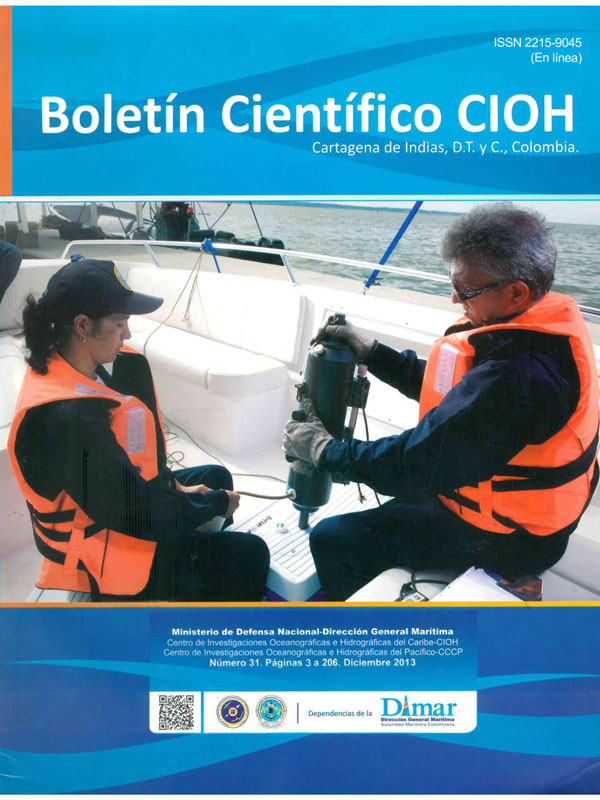Vertical reference datums determination for hydrographic applications in Cartagena Bay
DOI:
https://doi.org/10.26640/22159045.258Keywords:
hydrographic vertical datum, standardization, Cartagena's Bay, tidesAbstract
The Oceanographic and Hydrographic Research Center CIOH on behalf of the Maritime Authority DIMAR, committed to the process of regulation and standardization of the activities that take place in the jurisdiction of the Cartagena's port, especially bathymetric surveys carried out in the Bay, defined Datum or reference hydrographic vertical levels based on a methodology that combines the use of 2011 recorded water level data in the mareographic station located at the pier of CIOH in the Bay of Cartagena, mathematical calculations with the records obtained and field work results to establish the relationship between national geodetic network and vertical levels obtained, so that in this way generate the metadata that allows refer hydrographic survey to the levels determined according to the needs and purpose work. The Datum obtained were: MLWS (Mean Low Water Springs) used for referencing Colombian official nautical charting, LAT (Lowest Astronomical Tide) and MSL (mean sea level), all previous datums are recommended by the IHO (International Hydrographic Organization) for vertical referencingin hydrographic surveys especially MLWS and LAT. Also were calculated the MHWS (Mean High Water Springs) and HAT (Highest Astronomical Tide) datums. Adittionaly to the cartographic generation purposes, the results obtained will allow expand the range of products, analysis and derived studies from calculation, implementation and standardization of vertical levels such as of fusions with spatial data product of land surveying, use of the methodology for measuring rise and fall of water level through RTKGNSS technology being this one the highest accuracy available today in the development of hydrographic surveys, by the maritime authority have the support technical for require the standardization to same vertical reference level of hydrographic surveys development by external entitles, generating a efficient control that finally will resolve discrepancies that have occurred constantly when confronted products of different entities.Downloads
References
[2] National Oceanic and Atmospheric Administration. 2000. Tidal Datums and Their Aplicactions. NOAA Special Publication NOS CO-OPS 1.
[3] Dimar. Resolución 157 de 2011.
[4] OHI. 2008. Manual de Hidrografía Publicación C-13. Mónaco. 1 Ed. Capítulo 4, p. 273.
[5] OHI. 2008. Normas de la OHI para levantamientos hidrográficos. 5 Ed., p. 11.
[6] Instituto Geográfico Agustín Codazzi. 2004. Adopción del marco geocéntrico nacional de referencia MAGNA-SIRGAS como datum oficial de Colombia. Pp 11-12.
[7] Pons Valls, J. 2009. Universidad Politécnica de Cataluña. La medición del mar: principios y métodos. Mapping No.135 2009, pp. 6-10.
[8] Cárdenas, A., Bohórquez, N., Nieto, A., Fonseca, D. y Arias, J. 2011. Manual de Geodesia para Hidrografía. Dimar-CIOH, pp. 98-101.
[9] (FIG) International Federation of Surveyors. 2006. Guide on the Development of a Vertical Reference Surface for Hydrography, Publication Nº 37.
[10] Márques, N. 2000. The Importance of the Tidal Datum in the Definition of the Maritime Briefing Vol.2, No. 7 University of Durham.
[11] Turner, J.F., Iliffe, J.C. & Ziebart, M.K. 2009. Interpolation of Tidal Levels in the Coastal Zone for the Creation of a Hydrographic Datum.
Downloads
Published
Issue
Section
License
Attribution — You must give appropriate credit, provide a link to the license, and indicate if changes were made. You may do so in any reasonable manner, but not in any way that suggests the licensor endorses you or your use.
NonCommercial — You may not use the material for commercial purposes.
NoDerivatives — If you remix, transform, or build upon the material, you may not distribute the modified material.
No additional restrictions — You may not apply legal terms or technological measures that legally restrict others from doing anything the license permits.



